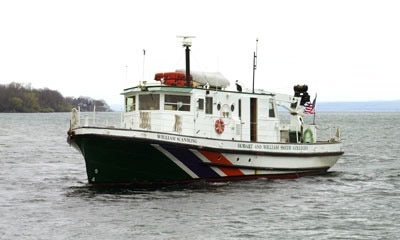The William Scandling

specifications
The William Scandling, a 65-foot, steel hulled research vessel is owned and operated by the Colleges for teaching, research and high school outreach activities. Its service area includes Seneca Lake, where most of the work is conducted, and extends via the New York Barge Canal System to Cayuga and Oneida Lakes, the lower Great Lakes, the Hudson River and points beyond. Since arriving on campus in the summer of 1976, it has provided a safe platform to investigate our large and sometimes stormy lakes during the ice-free months of the year.
The William Scandling is well equipped for both local and extended voyages by having state-of-the-art radar, GPS navigation, marine radio, cellular phone, fathometers, life boat and PFDs. A 200 horsepower GM Detroit diesel powers the single screw and two, 21 kW generators provide 120/240 VAC electrical power. The vessel is operated by a licensed captain who is assisted by a mate.
how it's used
The William Scandling is unique facility because no other undergraduate institution provides a similar opportunity for its students. Its primary function is to meet the teaching and research needs of the Colleges. Students have numerous opportunities to learn about the physical (waves, currents, etc.), chemical (dissolved ions, pH, etc.), biological (plankton, invasive mussel species, etc.), and geological (sediments, environmental history, etc.) properties of the lake. Introductory and advanced level courses use the vessel. In addition, upper-level students may conduct faculty supervised independent research projects. Look at the Geoscience, Biology, and Chemistrydepartment websites for more information on the coursework and research use.
Those outside the Colleges, including participating Science on Seneca high schools, colleges, universities, other teaching/research groups, and various (ex)presidents and senators are invited to make use of The William Scandling for their own similarly oriented programs.
standard scientific equipment
Scientific equipment list that is normally onboard includes:
- Hydraulically raised overboard boom
- Hydraulically powered winch with 1,500 feet of 1/4 inch stainless steel cable
- Five meter piston corer
- Sediment grab sampler
- Sieves
- Secchi disk
- Plankton nets
- Leica S9i Stereomicroscope
- Binocular Leica DM500 microscope with ICC50W Camera
- pH meter
- Pentium computer and HP printer
- Weather-monitoring sensors for temperature, pressure, and wind
- Sea Bird CTD (Conductivity, Temperature, Depth Profiler)
- Look at the Geoscience facilities webpage for other research-quality oceanographic equipment
